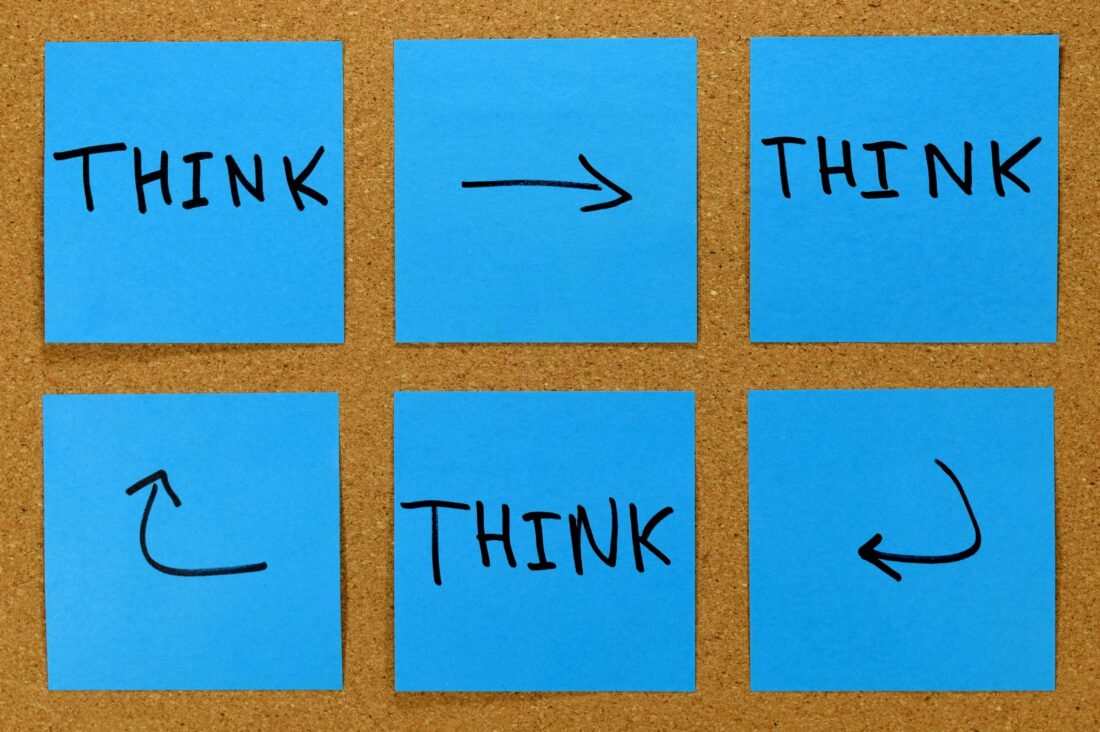STOP OVERTHINKING – JUST DO!
Some people think about a task or plan for so long that they never put it into practice. But the saying goes: “You always regret the things you didn’t do”. So here are a few tips on how to deal with typical thinking patterns that keep you from doing things.
In a conversation with a friend of mine, I was recently able to study how such a “thinker-mindset” works. I am the complete opposite. I act first and if it doesn’t work, I can always start thinking. Well, not quite so extreme, but almost.
My friend and I have been talking about her wanting to finish her new website at last. She has been talking about it for years, by the way. In the meantime, she’s making do with an ancient, self-designed and not very professional profile on the net. In her honour I have to say that she is still very successful with her consulting company. But a new web presence would still be important.
In our conversation I came across some “thinking errors” that could prevent such typical brooding people from implementing it:
THINKING ERROR 1: SOLVING THE SUBJECT ONLY IN YOUR HEAD
What if your mind is spinning around your plan, but you still can’t get into action? Then this mental roller coaster is probably the problem. The brain jumps from point to point and you can’t find the answers to the questions you are thinking about. It is also much harder for you to control whether you focus mainly on problems or on solutions.
My tip: Bring the topic on paper
Write or sketch on the subject. Make it visible and get an overview. Maybe you prefer mindmaps or creating a vision board from magazine clippings. Or maybe you just need a piece of paper and a pen. It doesn’t matter. Anything that helps you bring structure to your task or plan is good. Important: Ask yourself solution-oriented questions and answer them – also in writing. The question that stands above everything: “What do I have to do concretely to reach my goal?
THINKING ERROR 2: TOO MANY IDEAS
What if you have so many ideas that you cannot decide where to start? This leads to two basic problems: Firstly, you cannot focus and it becomes difficult to make a first step. Which is the right one? And what if another starting point would be better? Secondly, the task feels much bigger when you have to think of so many things at once. And that can also keep you from getting started.
My tip: Use the Marie Kondo method
If you follow my articles or videos, you know that I am a big fan of Marie Kondo’s tidying method. Her basic principle “Only keep what sparks joy” does not only work when it comes to things. For example, I have designed my website with this approach. First I wrote down all my ideas on sticky notes. But since I based my ideas on my old, overloaded homepage, there were far too many. Afterwards I picked, very ” selfishly” and selectively, only the points I really wanted to have.
The important thing is not to dwell too long on one idea, but to decide as spontaneously as possible.
It can also help if you set a number at which you want to end. In my experience, you rarely need more than three – three ideas, three values, three priorities, three first steps. Three is perfect for almost everything!
THINKING ERROR 3: SEE THINGS IN BLACK
What happens when you think so much that you see more and more problems and disasters coming your way? In my opinion that is the most critical point. Overthinking” is often accompanied by a certain pessimism. What if… I make the wrong decision… someone disagrees… it goes wrong? These considerations usually only take place in your mind, but can hinder the entire implementation.
My tip: Taggle it methodically
Again, writing helps. A good exercise that I learned years ago is: ” Doesn’t work because – Does work if”. To do this, split a sheet of paper into two columns. Head the left column with “Doesn’t work because” and the right column with “Does work if”. Now start on the left with your first problem: for example: I cannot continue to create my website because I haven’t got enough knowledge of design. Does work if I hire a designer. Doesn’t work because it costs too much money. Does work if I ask my friends if someone can help me – and so on. Solutions sometimes raise problems again, as in this example. Just keep going until you end up on the right column with a solution for which you can’t think of a problem anymore. Again, it is important that you proceed quickly with this approach.
AND WHAT IF ALL THESE TIPS DO NOT HELP?
If you still can’t break out of your roller coaster of thoughts and get into action, there are probably old blockages behind it. Don’t worry, many people have to struggle with them, but there is a remedy. In a couple of coaching sessions with Logosynthesis we will get to the bottom of it. You wouldn’t be the first overthinker who feels better afterwards.
By the way, in case you wonder why I can empathise so well with the psyche of an overthinker? Well, there is not only one tendency or the other, but mostly it is a mixture. And I also occasionally have an issue that occupies me more than is good for me. The ideas for solutions I introduced to you, I also apply myself from time to time. They almost always help, I promise!



No Comments